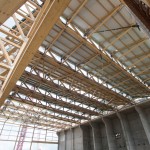Features - Business
2020 Shakes Construction to its Foundations

Chris Jones, Industrial Consultant for Odgers Interim, reflects upon the state of the UK construction industry in 2020 looking at how companies rose to the challenges and seized the opportunities presented throughout the year.
2020 has been a year many wish to set aside and forget – and not just the construction industry – with no one predicting the seismic events that have taken place. Back in January, a new government holding a healthy majority, the Brexit negotiations were in their final months of negotiation and there were policies in place to support infrastructure projects, with many predicting a bright and prosperous year for the sector. However, this year has not panned out quite that way and so we take a look, and reflect upon, how the construction industry has fared throughout this year of significant disruption.
After the original shock spring lockdown when the majority of businesses ‘downed tools’, the May 2020 ONS figures made for startling reading. Construction output fell 29.8% in the three months leading up to May. However, like a heavyweight champion knocked once to the canvas, the bounce back was quick. Whilst the initial period of lockdown slowed the industry, with April as the deepest low, May was the turning point with construction output growing by a record 8.2% margin. That month many construction companies were coming to terms with and adapting to events. Throughout the summer months, lockdown lifted and major building projects resumed development. The sector was no doubt buoyed by the ‘new deal’ announcement by the Prime Minister that infrastructure construction would be getting an extra £5bn of government funding.
Whilst the initial lockdown was a blow to the plans and finances of many construction companies, the industry demonstrated high levels of agility. Companies adapted quickly to overcome the challenges of the social distancing measures. In particular, digital transformation was brought to the fore as an urgent priority. A great example of this was the ingenuity of housebuilders to shift sales and marketing efforts online rather than via bricks and mortar. The digitisation of such procedures may have been an initial reaction to the disruption, but it also better equipped the industry to cope with challenges in the short term, whilst laying the foundations for future digital developments.
So, leaving aside the severe impact of Covid-19, this year has been momentous for the future of the construction industry. We have seen many companies up their game digitally, importantly with a great uptake in technology solutions. Emerging and rapidly developing technologies, such as smart machinery, robots, virtual reality, 5G and the IoT, are now being implemented to support all stages of the construction process. Big data has also proved more and more useful in design, mitigating risk and monitoring completed projects. Furthermore, the £5 billion being pumped into broadband rollout will drive this technology uptake going into 2021.
The autumn brought further positive news with construction output growing by 2.9% in September, the fifth consecutive monthly rise. This was still some 7.3% below February 2020 levels, but it was a clear indication the industry was heading in the right direction. Private housebuilding accounted for the lion’s share of the upturn no doubt because buyers are rushing to complete before the stamp duty holiday ends in March 2021.
Whilst some major projects have run into difficulties or have stalled as a result of the global pandemic, it was gratifying to see HS2 get the go ahead. This will certainly help some of the major contractors and their supply chains offset their loss of activity in other areas, such as airports and rail work.
The government’s push for a green economy built on new improved infrastructure is another fillip. The newly released will make inject a substantial £27 billion next year into the industry. Critical to this announcement, the funding will not be concentrated in the south east, as we have seen previously, but rather nationwide. This influx of support and funding to regionally based businesses will build the industry back up across the country as hopefully we see the tail end of the pandemic.
The other major topic of discussion has been environmental sustainability. The world-leading announcement of the 2050 zero-carbon sustainability has been at the top of the agenda. Determining the green credentials for all construction projects has now become standard practice, although many eco-friendly features remain an expensive luxury. We have seen more emphasis this year on proving a project’s green value, and if anything, Covid-19 has helped with this closer scrutiny. Again, 2020 has been a starting point with more still to come for the green agenda in construction – especially since the Prime Minister’s 2030 carbon target announcement just a few days ago.
Overall, the use of technology, the demand for green and the desire from the government to assist with funding has given greater confidence to the sector as a whole. This bodes well for construction looking to 2021. It has been a strange and disruptive year, with a series of highs and lows, but with order books filling up and bidding ramping up, the outlook appears more optimistic – and that is without the confidence boost a vaccine programme will give the economy. Here’s to looking to 2021 with renewed confidence about the opportunities, as opposed to threats, now available to the construction industry.
If you would like to read more like this, then please click here
link [JD1]
Related Articles
More Features
- Ten years of progress on payment, pre-qualification and skills
19 May 25
The industry has made significant progress on late payment, pre-qualification, and competence since the formation
- Pagabo provides clarity on impacts of new NPPS and PPNs
12 Mar 25
The Labour government’s new National Procurement Policy Statement (NPPS) sets out strategic priorities for public
- How is the Procurement Act going to drive social value
24 Feb 25
The regulations laid out within the Procurement Act 2023 will go live today.






